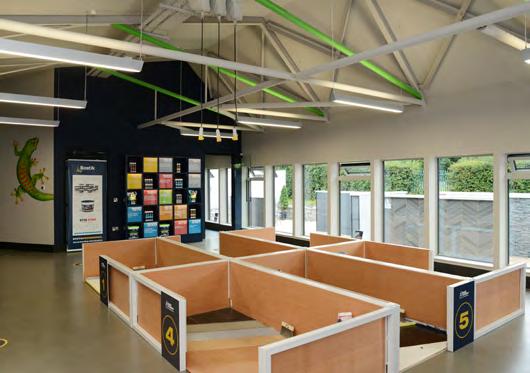
2 minute read
MANNOK AND FLSmidth CELEBRATE WORLD FIRST TECH TO DECARBONISE CEMENT PRODUCTION
Mannok and FLSmidth are celebrating the successful implementation of the FUELFLEX® Pyrolyzer, a new combustion system which has almost eliminated the use of fossil fuel in the most carbon intensive stage of cement production at Mannok’s plant, reducing carbon emissions by 240 tonnes per day, whilst significantly reducing NOx emissions.
The new FUELFLEX® system is enabling Mannok, at present, to replace 90% of its coal use with SRF (solid recovered fuels), which would otherwise go to landfill, in the pre-calcination stage of cement production and it is working towards eliminating the use of coal.
FLSmidth, the Danish engineering company which created the new technology, partnered with Mannok on the development of the world’s first pilot of the FUELFLEX® Pyrolyzer back in 2018, and during a launch event on Thursday 30th March, Lars Skaarup Jensen, FLSmidth’s Research and Development Specialist, explained the collaboration of the two companies for the design and testing of the system over the last four years, saying, “When we reached out to Mannok, FUELFLEX® was still very much at concept stage. We’d performed some testing in our lab in Denmark, but that is very different to deployment in a fully operational cement works. With the development and testing of completely new technology like this, you can expect it to throw up some issues along the way, and this pilot was not without its challenges. It required design revisions following initial tests to ensure continuous running of the FUELFLEX®, which involved expertise from both Mannok and FLSmidth. These revisions addressed issues which could only be identified through real-life testing, and we are very pleased that the system has now been running smoothly and effectively and has remained in operation for around nine months now.”
With the technology operating successfully at the Irish producer’s facilities since July 2022, it has already enabled Mannok to cut its fossil fuel use in the cement production process. The production of clinker, a precursor to cement, is the most fuel intensive part of the process, and the pre-calcination phase accounts for the largest portion of fossil fuel use, 60% of all fossil fuels in Mannok’s case. The ability to completely displace this use of coal is undoubtedly a major leap forward for the industry, and for Mannok, a company which has clearly and publicly defined its ambitious decarbonisation targets.
As Operations Director, Kevin Lunney, explains, “The key challenge for the entire cement industry is decarbonisation, and it’s our primary area of focus. We’ve set ambitious targets to reduce our carbon emissions by a third by the end of the decade and go on to achieve net zero by 2050. This requires innovative thinking, and we’re very proud to partner with FLSmidth and to help provide leadership in this space”.
Beyond fossil fuel displacement and the resulting reduced carbon emissions, another environmental benefit of this new technology is the reduction in Nitrogen Oxides, or NOx emissions, which the team at Mannok hadn’t really expected to achieve at the outset.
The new FUELFLEX® system achieves all of this by enabling the increased use of SRF as an alternative energy source to coal in the pre-calcination stage. The SRF is non-recyclable commercial waste, which would otherwise go to landfill, so this also serves a very beneficial waste management purpose. The SRF used is sourced from the counties immediately surrounding the plant, so Mannok are reducing shipping costs and the carbon footprint of imported fossil fuels by increasing their capacity to replace it with locally sourced SRF.
With such significant environmental and commercial benefits, FLSmidth’s FUELFLEX® technology could become a feature of cement production works across the globe, and for Mannok, this is the first major success in the company’s pursuit of net zero, with further significant innovation in sustainable energy already underway.









